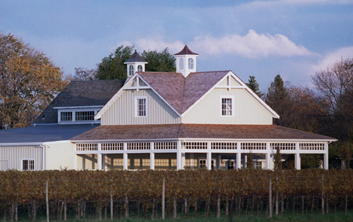New York’s Long Island Wineries An Inebriating Off-Season Getaway
October 5, 2009 at 9:04 am | Posted in off-season travel, wine tourism | Leave a commentTags: Cabernet Franc, Champagne, Chardonnay, East End, Greenport, Hamptons, Jamesport, Long Island, Mattituck, Meritage, Merlot, North Fork, Peconic, Sagoponack, South Fork, wine, wine country, wine tourism
by Jordan Simon

Merlot meets clapboard: Bedell Cellars is a prime example of a swell winery visit on Long Island's North Fork.
Despite its bodacious beaches and historic towns, New York State’s Long Island still cruises medium to low on the travel radar. Most Americans — even many New Yorkers — who know anything about the largest island in the U.S., flaring out from the Big Apple like an enormous forked tongue, think: NYC bedroom communities, then beaches (Fire Island, the tony Hamptons).
But how many appreciate that not only does New York State harbor the country’s oldest continuously operated winery, but that the Hamptons teemed with vineyards 150 years ago and today’s East End offers some of America’s most engaging, even eminent wine country?
Indeed, the region bears an uncanny geographic resemblance to Bordeaux, whose top varietals thrive in similar conditions: a temperate maritime climate warm enough to ripen the fruit, cool enough to produce brisk acidity, while the breezes extend the frost-free growing season, reduce temperature extremes, and concentrate precipitation in the desired winter months. I consider the Island’s red Bordeaux varietals — especially the earlier-ripening Merlot and Cabernet Franc — its top products; its Meritage blends are also excellent. The Cab Francs are the New World’s most promising and complex, exhibiting the grape’s tannic masculinity yet elegance, with textbook aromas and flavors but distinctive terroir-driven notes. Along with some notable whites, sparklers, and rosés, these wines are produced to pair with the region’s rich bounty, from oysters to duck. Vintners experiment and marry newfangled equipment with Old World knowledge, including globally “imported” winemakers and consultants.
Forty-one wineries (most along a 22-mile North Fork stretch) welcome visitors for tours and tastings; you can decide which Long Island wines strike your fancy at LIWines.com. Though tendrils of trendiness creep across the Long Island Sound, the increasingly Napa-fied North Fork remains down-home compared to the South Fork’s upscale Hamptons, with rates surprisingly low now during fall harvest time, when leaves turn pyrotechnically. After beach season, activities still abound: wildlife reserves, historic villages and lighthouses, art galleries, even some outlet shopping.
There’s also a nice selection of family-run motels, inns, B&Bs, even farmhouses — many historic — which often reflect innkeepers’ charming idiosyncrasies (Red Barn B&B has its own astronomical observatory, Freddy’s House B&B a working hydrangea farm), offering warmth over whimsy. In Greenport, I particularly like the Norman-Rockwellian Harborfront Inn (from $199, including dinner credit and bottle of wine), contrasting traditional architecture with contemporary style and amenities, and Bartlett House (from $150), whose rooms (some Asian- and African-themed) exhibit fabulous flair. Meanwhile, in Mattituck, Shinn Family Vineyards Estate Farmhouse is the Island’s only working winery where you can stumble into bed after a vino-soaked evening (from $149). The Country Inn at Jamesport (from $100) and Greenport’s beachfront Silver Sands Motel (from $125) should satisfy savings seekers.
Eats-wise, among the better restaurants, most emphasize a warm, family-run welcome and fresh, seasonal, local “slow” food. My picks: Greenport’s Bay & Main, Soundview, or Scrimshaw; Mattituck’s Touch of Venice; Jamesport Manor Inn, and Jamesport Country Kitchen; Shelter Island’s Vine Street Café and Pridwin Beach Hotel; and Southold’s North Fork Table & Inn.
As for the wineries themselves, many respect traditional “shack chic” architecture, renovating weatherbeaten potato barns, while a few reflect their powerhouse owners’ less grapey passions. Many offer regular events and entertainment such as live music spring through fall. Here’s a quick tasting, all with daily tastings year round (other top options include Macari, Martha Clara, Palmer, Paumanok, Roanoke); swirl and spit, please.
Bedell Cellars In Cutchogue, on the North Fork, Kip Bedell earned the moniker “Mr. Merlot” pioneering the prevailing style: Upon release, they’re “young, virile, and awkward,” Bedell laughs, yet upon maturing purr with Porsche power and polish. The tasting room, a soaring expansion of the original 1919 barn, holds owner Michael Lynne’s world-class art collection. Tastings from $8 per person.
Lenz Winery One of the North Fork’s oldest, occupies an original Peconic barn sporting timber beams and thatching; photos of the vineyards and workers adorn rough-hewn walls. Far from being rustic, Eric Fry’s wines display exceptional finesse; in blind tastings his Chardonnays and Merlots have tied with French bottlings, including the fabled Pétrus (8x the price), and his bubblies compare favorably with artisan Champagnes. Tastings from $5.
Raphael Winery Also in Peconic, the architectural style’s Italianate, including a bell tower, thick wood beams, stone columns, hand-carved zigzagging staircases, marble accents, vaulted ceilings, and medieval tapestries. The vinous style’s more French (Bordeaux biggie Paul Pontallier of Château Margaux was originally a consultant), starring mesmerizing Merlots and sassy Sauvignon Blanc. Tastings from $8.
Wölffer Estate Near the Hamptons town of Sagoponack, German-born mega-developer Christian Wölffer’s 55-acre Tuscan-style spread is all beam-crossed cathedral ceilings, terracotta floors, massive French doors, spidery wrought-iron chandeliers, and stained glass, showcasing Wölffer’s centuries-old pewter and faïence mug collection, botanical gardens, and equestrian center (hey, it’s polo/Ralph Lauren country, too). Chardonnay, Merlot, and rosé are the name of winemaker Roman Roth’s game. Tastings from $12.
More info: Tripatini.com’s Wine Tourism and New York State groups.
A Low-Season High Time in Rio de Janeiro
July 29, 2009 at 1:34 pm | Posted in off-season travel, South America | Leave a commentTags: "Rio de Janeiro", "samba schools", Brazil, cachaca, Carnaval, samba, spirits

The sweeping view over Rio's Botafogo Bay
By Jen Karetnick
If you’re still searching for a last-minute getaway this summer, low season in South America, which runs from early June through early September, means bottoming prices in both airfare (check LAN’s sales) and in the cities. But whenever you go, even beyond visiting the famous beaches, Sugarloaf, Santa Teresa, the favela tour, Paquetá Island, and Tejuca Forest, the stuff to do in Rio de Janeiro — one of the best places to experience Brazil in a nutshell — in particular get an “A-plus.” Like what, you wonder? Olha, que coisa mais linda, as the song goes:
Academia da Cachaça (www.AcademiaDaCachaca.com.br) Located in Leblon, right next to Ipanema, the Academia was conceived as a place where 130 years of gastronomy and regional production of Brazil’s quintessential sugarcane-based firewater could be um, “studied.” It’s ideal for the novice to begin lessons with a Caipira Acadêmica (citron, cachaça Seleta and honey) and a plate of small toasts with cheese curd and dried tomato. You even have the option of tasting the 80-plus cachaças on the ever-changing list — pretty much a many-hour endeavor. So while you might go over budget on the drinks, you’ll be under all day. And maybe the next one, too.
Acadêmicos do Salgueiro (www.Salgueiro.com.br) The humongo blowout that is Carnaval takes place in February (in 2010, the 13th through 16th), but participants are practicing up a storm even now, and one of the most important groups is Salgueiro. Brazilians call this a “samba school,” but it’s more like a huge dance hall, where band after band takes the stage and hundreds of revelers shake their bundas. For first-timers, it can be intimidating, so down a few Cabana Cachaça caipirinhas to take the tummy jitters away. Then dance the night (and sleep the following morning) away (see below for a quick taste!).
Restaurante Aprazível (www.Aprazivel.com.br) Santa Teresa is the lovely, cobblestone-paved colonial neighborhood up the hill from the beaches, and complete with veranda and thatched gazebo, Aprazível (“pleasant”) is quite the culinary charm school. Chef-proprietor Ana Castilho relies equally on her grilled fish in orange sauce and coconut rice and the view of Rio below to keep her guests entranced. It’s a bit of a splurge for Brazil (mains start at US$24), but worth it — take your time and enjoy the solitude above the clouds. Aprazível, indeed.
Arpoador (www.Ipanema.com/CityTour/Arpoador.htm) Sure, you’ve been to Key West and toasted the sunset — maybe even spotted that elusive “green flash” — but you’ve still got a thing or two to learn. And that’s what this impressive rock formation, which borders Ipanema Beach and is a favorite nightly — and complimentary — stop, is here to teach ya. If you’re a surfer, you’ll also want to get schooled on these humdingers. Renting a board will cost you a few reais, but as long as you don’t break the board, it shouldn’t break your banco.
Finally, let me leave you with a good beach read, if you can tear yourself away from the “sights”: Those Ipanema and Copacabana sands call for some words of wisdom and Frances de Pontes Peebles’ The Seamstress, which fictionalizes 1930s Brazil, fits the bill. By the time you’ve finished this 646-page account of cangaceiros (outlaws) and politicos, your knowledge of Brazilian history will rival a native’s—and so will your tan.
Bom viagem!
Sneak Post-view: here’s a technical rehearsal for Acadêmicos do Salgueiro’s 2009 performance.
Blog at WordPress.com.
Entries and comments feeds.
